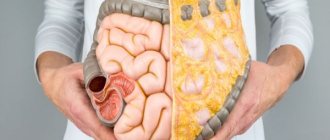Definition and classification
Megacolon is said to exist if the x-ray shows a pathological increase in the diameter of the colon:
- blind – more than 12 cm;
- ascending – 8 cm;
- descending and sigmoid - 6.5 cm.
In clinical practice, there are three types of megacolon:
- spicy,
- chronic,
- toxic.
Acute megacolon (Ogilvie's syndrome) is an enlargement of the colon that occurs in patients with severe surgical diseases. The chronic version lasts for several months or more. It is caused by persistent intestinal dysfunction, such as in Hirschsprung's disease or muscular dystrophies. Toxic megacolon is provoked by various infections: bacterial or pseudomembranous colitis, Chagas disease, etc.
Causes
Congenital intestinal hypertrophy occurs due to improper distribution of nerve cells in the wall of the organ during its formation (embryogenesis). With this type of pathology the following is observed:
- deficiency or complete absence of nerve receptors in the intestinal wall;
- inferiority of receptor endings - deterioration in the conduction of nerve impulses.
Acquired megacolon also develops due to disruption of the conduction of nerve impulses to the intestinal wall.
This leads to:
- intoxication with various poisons;
- disorders in the central nervous system - tumors, injuries, cerebral ischemia;
- intestinal injuries and tumors;
- long-term chronic constipation, leading to the death of the receptor apparatus.
Under the influence of these factors, colon motility deteriorates in various parts, and over time, the lumen of the organ gradually decreases.
Such a mechanical obstruction disrupts the movement of intestinal contents. An enlarged area forms above the narrowing of the intestinal lumen.
Gradually, compensatory thickening of the wall occurs. In this way, the body tries to cope with stagnation of intestinal contents. But over time, the death of muscle fibers and the formation of scar tissue begins in this area.
The process of movement of feces through the intestines slows down, and long-term constipation occurs - up to a month. Dysbacteriosis and chronic intoxication of the body develop.
Causes
Depending on the etiology, megacolon is divided into primary (congenital) and secondary (acquired). The primary form is Hirschsprung's disease. This is a congenital pathology, which is based on the absence of intramural (inside the intestinal wall) nerve plexuses. Because of this, functional obstruction occurs due to distal narrowing, often in the rectal area. The direct cause of Hirschsprung's disease is a genetic mutation on four chromosomes.
Megacolon is said to be acquired if no congenital gastrointestinal pathology (aganglinosis, stricture or atresia) is detected. Typically, the pathology develops against the background of atonic constipation. The latter, in turn, provoke various diseases, including the gastrointestinal tract:
- mechanical intestinal obstruction (tumor, helminthic infestation);
- infectious and inflammatory bowel pathologies (Chagas disease, pseudomembranous colitis, etc.);
- surgical operations;
- Parkinson's disease;
- myotonic dystrophy;
- diabetic neuropathy;
- collagenoses (for example, scleroderma);
- hypothyroidism;
- hypokalemia;
- porphyria;
- pheochromocytoma.
Acquired megacolon can also be idiopathic. That is, there are clinical manifestations of the disease, but its exact cause has not been established.
The prevalence of chronic megacolon, such as Hirschsprung's disease, is 1 in 5000 births. The congenital form of the disease is more often diagnosed in boys than in girls (4:1). Secondary megacolon occurs with equal frequency in both men and women.
Intestinal megacolon
It is important to note that megacolon is the term used to describe dilatation without mechanical obstruction. It is clear that the colon will dilate if there is a mechanical obstruction that prevents the outflow of its contents. Although the colon can stretch, there is a point at which it can be considered overdistended. The stretch also prevents the muscles in the colon wall from functioning properly, so the contents cannot move around.
Normal colon activity
The colon, like the entire gastrointestinal tract, has muscular walls. These muscles contract in a coordinated manner, pushing food and waste through the intestines. When food, waste, or any other object gets into part of the intestine, it causes a slight stretching of the intestinal wall. This signals the intestines that there is content in this segment that needs to be moved. Stretch signals are sent back to the spine, which in turn signals the intestinal wall to contract. This is known as the nerve reflex. These contractions then push the contents down.
It is important to note that megacolon is the term used to denote dilation without mechanical obstruction
This way, the contents of the intestinal segment cannot accumulate excessively and cause abnormal distension of the intestinal wall. This also ensures that movements are properly coordinated rather than parts of the intestine contracting and relaxing excessively, which can cause backflow of contents. This simple but effective mechanism begins at the moment of swallowing and continues throughout the intestines until waste and undigested material is expelled as stool.
Causes of megacolon
The exact mechanism of megacolon occurrence is not fully understood. Megacolon does not occur when there is a mechanical obstruction that prevents the movement of colon contents. Instead, it appears that megacolon may be due to a muscle or nerve problem, or perhaps a combination of both. As explained, if stretching the colon wall does not send signals to the nervous system, which in turn sends a signal back to the wall, then the muscles in the wall will not contract. Likewise, if the muscles are not functioning properly, they cannot contract at the right time to push the contents.
Therefore, the problem may be related to:
- Conduction of nerve impulses and reflexes.
- Neurotransmitters that transmit signals across the gap.
- Overstimulation of muscles by regulating nerves, preventing them from contracting (sympathetic) or relaxing (parasympathetic).
- Reducing the influence of regulatory nerves (parasympathetic nerves), which prevents their contraction.
- Excessive amounts of opioids acting on opioid receptors impair reflexes.
Symptoms
Megacolon is characterized by nonspecific symptoms:
- abdominal pain;
- bloating and rumbling;
- constipation
Congenital megacolon (Hirschsprung's disease) usually develops immediately after birth. The baby passes a small amount of feces (meconium) in the first few days after birth, but the abdomen remains enlarged. Stool occurs only after a cleansing enema or the use of laxatives. If intestinal obstruction develops, vomiting, abdominal pain, and bloating occur.
Prolonged constipation is one of the signs of chronic megacolon Photo: shutterstock.com
If the disruption of intestinal innervation is partial, then symptoms may appear later, after several months. Frequent constipation is common, even despite taking medications. Due to digestive disorders, anemia and malnutrition (physical underdevelopment) develop. The child is often sick and has a weakened immune system.
The acquired form of the pathology is diagnosed in older children and adults. Chronic megacolon manifests itself with the same symptoms, but they are less pronounced than with a congenital disease. The process of nutrient absorption is disrupted to a lesser extent, so the patient’s general condition is usually not impaired.
Constipation with secondary megacolon lasts more than a week. Sometimes it is possible to palpate compressed stool in the lower abdomen. In some patients, fecal incontinence occurs due to reflex atony of the anal sphincter.
If the disease develops acutely, for example, against the background of infectious colitis or obstruction, a clinical picture of intestinal obstruction develops. Sharp abdominal pain, cessation of gas discharge, vomiting, nausea, and increased body temperature occur. In this case, you should immediately seek medical help.
What is megacolon?
What is megacolon?
Marked enlargement of part of the large intestine or the entire organ is called megacolon. Often, this disease is observed in early childhood. In some cases, it appears already in the first days or months of life. In this case, intestinal hypertrophy is classified as a congenital malformation of the digestive system. Less commonly, pathological enlargement of the organ is observed in adulthood. In such cases, the disease is considered secondary, that is, developing against the background of some other ailment. Intestinal hypertrophy occurs due to its lengthening, thickening of the walls and expansion of the lumen. Often, changes affect the distal sections. To diagnose megacolon, instrumental examinations of the digestive tract are used. The treatment tactics for the disease in most cases depend on the cause of intestinal hypertrophy. The main indication for surgery is complications or risk or development.
Diagnostics
If stool retention occurs in a newborn, then Hirschsprung's disease is first ruled out. In the secondary form of the disease, it is necessary to identify the etiological factor leading to intestinal dilatation. It is important to differentiate between congenital and acquired forms of megacolon. The treatment approach and prognosis depend on this.
Diagnostics includes the following instrumental research methods:
- irrigoscopy (x-ray of the intestines with the introduction of contrast);
- computed tomography;
- colonoscopy;
- anorectal manometry.
To confirm Hirschsprung's disease, aspiration biopsy of intestinal tissue is necessary. The absence of nerve ganglia on histological examination confirms the diagnosis.
In case of toxic megacolon, a bacterial examination of the stool is additionally performed to identify the causative agent of the disease. In this case, it is not recommended to do a colonoscopy due to the high risk of intestinal perforation.
Diagnosis of megacolon
When making a diagnosis, the doctor is based on data obtained during a patient interview, symptoms of the disease, as well as additional special studies. The key symptoms that confirm the presence of megacolon in a patient are constipation, lack of stool, the presence of a narrowed part of the colon and bloating. In the practice of diagnosing megacolon, the following methods are used:
- X-ray examination (performed after bowel cleansing). On a plain X-ray of the patient, such manifestations of the disease as the presence of dilated and swollen loops of the colon, as well as a rather high position of the dome of the diaphragm, are noted.
- X-ray contrast techniques. This diagnostic method involves injecting barium into the rectum and examining it under x-ray in different projections. During this study, four radiographs are taken from different angles: one each in the direct and lateral positions, as well as two after bowel movement. In this case, the first two radiographs are taken with the intestine full in order to accurately determine the degree of expansion of the area near the expanded part of the intestine.
- Rectal biopsy. It is one of the most important and reliable diagnostic techniques. Used to confirm the absence of nerve nodes in the muscular and submucosal parts of the rectum. A biopsy is performed in the area of the muscle sphincter - above the internal sphincter.
- Rectal manometry. Using this technique, the functional state of the rectoanal zone is assessed. Namely, the technique makes it possible to identify such symptoms of the disease as the absence of the rectoanal reflex, a significant increase in muscle sphincter, as well as an increase in the maximum tolerated volume.
- Irrigoscopy. Necessary to determine areas of narrowing of the colon, lack of folding, and presence of smooth contours.
- Colonoscopy and sigmoidoscopy are used for a thorough examination of the large intestine.
- Differential diagnosis is carried out in the case of colon tumors, irritable bowel syndrome, chronic colitis, constipation, diverticular disease.
Treatment
Acquired megacolon is treated conservatively or surgically. As a rule, they begin with therapeutic measures aimed at eliminating constipation and normalizing intestinal activity:
- laxatives;
- cleansing enemas;
- prokinetics (Itomed).
A high fiber diet is prescribed. The menu must include the following products:
- vegetables and fruits;
- nuts;
- seeds;
- whole grain cereals;
- dried fruits;
- legumes;
- sea kale.
Vegetable oils (olive, flaxseed) and avocado improve intestinal function. You can add wheat bran or psyllium (psyllium husk) to your dishes.
For toxic megacolon due to enterocolitis, gastroprotectors (Rebagit), probiotics (Bifiform), and steroids or antibiotics, if indicated, are prescribed. At the same time, correction of water and electrolyte balance and detoxification therapy are carried out.
If there is no effect from conservative treatment, surgery is recommended. It is also indicated for congenital megacolon (Hirschsprung's disease). In the toxic form, the indication for surgery is the lack of effect of drug therapy within 24-48 hours.
The choice of technique is based on the degree of intestinal dysfunction. The following types of operations are possible:
- Ileostomy. Indicated for slow intestinal motility. Usually performed on middle-aged and older patients.
- Ileorectostomy. It is carried out with the defecation mechanism preserved. Recommended mainly for older people.
The following operations are recommended for children with Hirschsprung's disease:
- Colon decompression with colostomy;
- Resection of a section of intestine without nerve ganglia and formation of an anastomosis.
Hirschsprung's disease (aganglionic megacolon)
Hirschsprung's disease (N. Hirschsprung, 1887) is a malformation of the left half of the colon, caused by the complete absence of ganglion cells in the intermuscular (Auerbach) and submucosal (Meissner) plexuses. Aganglionic megacolon is essentially a neurogenic form of intestinal obstruction. The disease is a congenital pathology (noted in a ratio of 1:5000 children born). It occurs more often in children and adolescents, less often in adults. Boys get sick 4-5 times more often than girls. Hirschsprung's disease is familial, caused by an abnormal locus in the structure of the 10th chromosome. About 5% of children with Hirschsprung disease have Down syndrome. If the aganglionic portion of the intestine is small and localized in the anorectal region, then symptoms of the disease may appear in adulthood. This type of disease is called "adult Hirschsprung disease."
Etiology and pathogenesis. The aganglionic zone most often begins from the anorectal line and in 80-90% of cases extends to the rectosigmoid region, in 10% it extends to the splenic flexure or to the entire colon and distal small intestine. The lack of parasympathetic innervation leads to a delay in relaxation of the internal sphincter of the rectum; there is also a lack of synthesis of nitric oxide (NO), which causes relaxation of the sphincter. A section of the intestine devoid of intramural nerve ganglia is constantly contracted spastically and does not peristalt; as a result, the upstream sections of the intestine, which have normal innervation, expand and hypertrophy, and megacolon occurs.
Pathological picture. There are no nerve cells in the aganglionic zone. Histological examination of dilated sections of the colon reveals hypertrophy of muscle fibers simultaneously with sclerosis and their replacement with connective tissue. This leads to a sharp thickening of the intestinal wall.
Clinical picture and diagnosis. With a short aganglionic segment, the symptoms of the disease are easily relieved by the administration of cleansing enemas and laxatives; with a long one, the disease can occur in the form of obstructive obstruction.
According to the clinical course, compensated (mild), subcompensated (moderate) and decompensated (severe) forms are distinguished. The severity of the disease depends on the extent of the aganglionic portion of the colon. With a small extent of the aganglionic area, children develop a mild form of the disease. Good child care and regular bowel movements using enemas or gas tubes contribute to long-term compensation. In the decompensated form, from the first days of life the disease manifests itself as symptoms of low-grade colonic obstruction.
Violation of the passage of intestinal contents and the accumulation of feces in the form of a “plug” from the first weeks of life determine the clinical manifestations of Hirschsprung’s disease, the main symptoms of which are constipation, bloating, pain, and rumbling in the abdomen. Constipation can be persistent and is observed from the moment the child is born or in early childhood. Stool retention can be long-term - from several days to several months. A constant symptom of the disease is also bloating (flatulence), sometimes reaching such a degree that it makes it difficult for the patient to breathe. It is typical that bloating remains even after bowel movement with an enema. Due to constipation and bloating, pain appears throughout the abdomen, which disappears after bowel movement. Prolonged stool retention may be accompanied by weakness, nausea, vomiting, loss of appetite; children develop anemia, malnutrition, and widening of the rib cage. Sometimes constipation is replaced by diarrhea (paradoxical diarrhea), which lasts several days and leads to exhaustion and sometimes a collapsing state of the patient. Diarrhea is caused by inflammatory changes in dilated loops of the intestine, sometimes ulceration of the mucous membrane, and dysbacteriosis.
Upon examination, an enlarged abdomen (constant flatulence) is revealed; sometimes peristaltic contractions of the intestine can be observed and dense stool can be felt. During a digital examination of the rectum, an increase in the tone of the anal sphincter and an empty ampulla of a spastically contracted rectum are determined. X-ray examination in a vertical position reveals intestinal loops swollen with gas, characteristic of intestinal obstruction. During a colonoscopy, due to a spasm of the rectum, the rectoscope initially moves with difficulty, and then it seems to fall into its expanded part, which is always filled with feces and fecal stones. Irrigoscopy makes it possible to identify the narrowing zone, its extent and localization, the extent of the expanded suprastenotic zone of the colon, the diameter of which is usually 10-15 cm. When studying the passage of barium suspension through the digestive tract, a long-term (for several days) retention of the suspension in the expanded parts of the colon is revealed .
Transanal biopsy of the rectum allows you to verify the diagnosis. Histological examination of the biopsy specimen reveals aganglionosis or a sharp decrease in ganglia in the intermuscular nerve plexus. A biopsy during surgery is especially valuable in determining the level of resection of the affected bowel.
With the slow development of the process, patients can compensate for it for quite a long time, achieving bowel movement with the help of cleansing enemas, and only with decompensation (already in adulthood) do indications for surgical treatment arise.
Complications. Hirschsprung's disease can be complicated by intestinal obstruction, inflammation and ulceration of the mucous membrane in the dilated parts of the colon, intestinal perforation, and bleeding.
Treatment. Conservative treatment is only a preparatory stage for surgery. It consists of measures aimed at emptying the intestines (diet regimen, laxatives, cleansing enemas, pro kinetics - coordinax, etc.). Intestinal obstruction that cannot be resolved by conservative measures is an indication for a colostomy in the proximal colon. Many experts consider colostomy as the first stage of surgery (preparing the patient for radical surgery). Surgical treatment consists of removing the aganglionic zone and decompensated dilated sections of the colon, followed by restoration of intestinal patency. In children, the Duhamel, Soave, and Svenson operation is most often used. Postoperative mortality in recent years, as a rule, does not exceed 2-4%.
Prognosis and prevention
With timely treatment, the prognosis for megacolon is favorable. After radical surgery for Hirschsprung's disease, improvement is observed in 90% of patients. If left untreated, life-threatening conditions may occur: infectious-toxic shock, water-electrolyte imbalance, sepsis.
Prevention of megacolon is aimed at preventing the etiological factor. To prevent constipation, you need to eat more foods with fiber (vegetables, fruits, whole grain bread, nuts). At the same time, exclude from the diet foods that slow down intestinal motility: sweet pastries, potatoes, rice, chocolate. To prevent congenital megacolon, pregnant women should adhere to a healthy lifestyle, give up bad habits and unnecessary medications.
Functional megacolon
The development of pathology is based on a mechanical barrier that prevents the unhindered passage of feces through the intestines. Treatment is surgical; initially, the issue of restoring patency (removing the causes of obstruction) is considered, taking into account the degree of preservation of the functional ability of the intestinal wall. In advanced stages, surgical intervention involves excision of the pathologically changed part of the intestine, followed by anastomosis.
Sometimes the volume of the resected section does not allow the operation to be performed while maintaining normal bowel movements at one time, and then they resort to an ileostomy or colostomy - an unnatural opening with a colostomy bag removed. If the patient is safe (no severe concomitant pathology), after some time it is possible to perform reconstructive surgical correction, which is aimed at restoring independent bowel movements.










